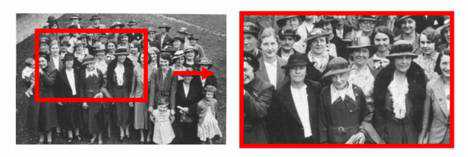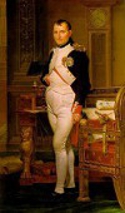




Wikipedia
http://en.wikipedia.org/wiki/Ken_Burns_effect
Ken Burns Effect

These images illustrate the Ken Burns effect.
The Ken Burns effect is a popular name for a type of panning and zooming effect used in video production from still imagery.
The name derives from extensive use of the technique by American documentarian Ken Burns. The technique predates his use of it, but his name has become associated with the effect in much the same way as Alfred Hitchcock is associated with the Hitchcock zoom.
The name The Ken Burns Effect was used by Apple[1] in 2003 for a feature in its iMovie 3 software. The feature enables a widely used technique of embedding still photographs in motion pictures, displayed with slow zooming and panning effects, and fading transitions between frames.
Usage
The technique is principally used in historical documentaries where film or video material is not available. Action is given to still photographs by slowly zooming in on subjects of interest and panning from one subject to another. For example, in a photograph of a baseball team, one might slowly pan across the faces of the players and come to a rest on the player the narrator is discussing.
The effect can be used as a transition between clips as well. For example, to segue from one person in the story to another, a clip might open with a close-up of one person in a photo, then zoom out so that another person in the photo becomes visible. The zooming and panning across photographs gives the feeling of motion, and keeps the viewer visually entertained.
Secondary meaning
The term has also been used less formally to refer to a person who gains an increased degree of celebrity after appearing in a Burns documentary. Such people include Shelby Foote and Buck O'Neil.[citation needed]
Origins of the technique
Burns has credited documentary filmmaker Jerome Liebling for teaching him how still photographs could be incorporated into documentary films.[2] He has also cited the 1957 National Film Board of Canada documentary City of Gold, co-directed by Colin Low and Wolf Koenig, as a source of inspiration for this technique.[3][4][5] Winner of the Palme d'or at the Cannes Film Festival and nominated for an Academy Award,[6] City of Gold used animation camera techniques to slowly pan and zoom across archival still pictures of Canada's Klondike Gold Rush.[7]
The British Broadcasting Corporation's documentary series The Great War, first shown in 1964, used both extensively.[citation needed]
Implementation
In film editing, the technique may be achieved through the use of a rostrum camera, although today it is more common to use software. Non-linear editing systems such as iMovie and Openshot for Linux include an effect or transition called Ken Burns Effect, with which a still image may be incorporated into a film using this kind of slow pan and zoom. Final Cut Pro,[8] Apple TV and Apple's iPhoto photo editing program include a photo slideshow option labeled "Ken Burns Effect".[2]
On the Windows platform, AVS Video Editor, Windows Movie Maker, Pinnacle Studio, Sony Vegas Studio (and Movie), Ulead VideoStudio, PicturesToExe also have pan and zoom features built in or available through third party extensions which may be used to achieve the effect. Microsoft Photo Story is a free application that creates videos with both random and customiseable Ken Burns Effects automatically from selected images. Another free multiplatform Ken Burns effect application is PhotoFilmStrip
On the Mac platform, Final Cut Pro, Final Cut Express, iMovie, Adobe Premiere, and others also have the ability. Particularly, Adobe and Apple products (excluding iMovie) allow the user to set keyframes to further customize the process.
The effect is found in a great number of screensavers and slideshows. Apple uses it in their screensavers. Windows PCs can use Greg Stitt's "MotionPicture" and Gregg Tavares's "Nostalgic", among others. The effect can also be seen in the N73 smartphone by Nokia, applied to the slideshows the phone creates from the pictures stored in it.[9] Many seventh-generation video game consoles also feature versions of this effect, including Nintendo's Wii Photo Channel, Sony's PlayStation 3 and within the Last.fm app for Xbox360.
Outside of screensavers and slide shows, the effect is also found in some video games.
Examples
The Story about Ping, 1955, Weston Woods Prod Co.
Georgie, 1956
Night of the Living Dead, 1968, Directed by George Romero
Comic Book Confidential, 1988, Directed by Ron Mann
The Civil War, 1990, Directed by Ken Burns
The Old Negro Space Program, 2005
[edit] See alsoMotion control photography
Pan and scan
Photoanimation
Photo slideshow software
References^
"Jobs Masterful During Macworld Keynote, Derrick Story.". O'Reilly. 2003.
^ a b Kennedy, Randy (2006-10-19). "The Still-Life Mentor to a Filmmaking Generation". The New York Times. "In fact, spend any time watching the films of Ken Burns, or those of the legions of documentary makers he has inspired, and you will see Mr. Liebling�s work, in a sense, even if you have never laid eyes on one of his photographs."
^ Vause, Mikel (Fall 2006). "Capturing the American Experience: A Conversation with Ken Burns". Weber Studies 23 (1). ISSN 0891-8899. OCLC 11872924. Archived from the original on 2007-10-13.
^ Williams, Charles (1997). "Historical Photographs and Multimedia Storytelling".
^ Tibbetts, John C. (c. 1997). "All That Glitters: City of Gold Revisited" (PDF).
^ "Colin Low" (biography, filmography). The Film Reference Library. January 2003.
^ Wise, Wyndham; Glassman, Marc (Spring 1999). "Filmaker of vision; Take One's interview with Colin Low pt1". Take #1 25. OCLC 60624126.
^ Kobler, Helmut; Fahs, Chad (2003). Final Cut Pro 4 Dummies. For Dummies. Wiley. pp. 73, 311. ISBN 0764537539.
^ "Nokia N73 Data Sheet" (PDF). Nokia. 2006.
External links
The National Geographic (specials and series)
Using Stills in Motion Picture Media: Keep the Show Moving, or Bring it to a Halt?
MotionPicture Slideshow Screensaver for Windows
Categories: Film techniques Documentary film techniques

